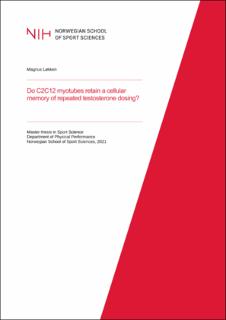| dc.description.abstract | Introduction: Testosterone is a vital male sex hormone responsible for many physiological processes in the human body. In addition, it elicits a hypertrophic effect on the human skeletal muscle. Due to this effect, some explore abusing synthetic variants of testosterone to gain performance in sports or enhance their physique. Previous studies have alluded to that this effect is retained after the individuals stop using the substances, a 'muscle memory' of doping. This thesis aimed to investigate the muscle memory of repeated testosterone administration, looking at gene expression values of differentiation markers and genes that have previously retained a memory of anabolism induced by resistance exercise.
Methods: C2C12 myotubes were dosed at an early (day 3) and/or late (day 7) stage of differentiation using supraphysiological doses of testosterone (100 nmol). There were four conditions during this experiment. Early testosterone (ET), late testosterone (LT), early and late testosterone (ET+LT), and controls only treated with differentiation media (DM). Morphological data analysis (myotube numbers, area and, diameter) and gene expression analysis of selected genes were used to assess the effect of this dosing.
Results: The morphological data showed that the ET+LT condition at day 10 had significantly greater myotube numbers (P ≤ 0.0001) than all other conditions. More importantly, it was significantly greater than the LT condition suggesting that ET+LT retained a 'memory' of this first dosing at day 3 supported by the fact that ET alone did not evoke any morphological difference vs. DM control. Analysis of myotube size (area and myotube) observed a similar ET+LT > LT > ET and DM trend on day 10, although not all of these numbers reached significance. The gene expression analysis did not indicate that the genes selected due to their association with 'muscle memory' were involved in the observed morphological memory.
Conclusion: C2C12 myotubes retain a morphological memory of testosterone-induced hypertrophy when later re-encountering testosterone at a late stage of differentiation. However, this memory was not reflected in the 'muscle memory genes' observed with resistance exercise-induced hypertrophy. | en_US |
